





Leek
Leek – a perennial herbaceous plant from family Bulbous. Its homeland – the Mediterranean, remained a wild-growing form of these onions there. In general leek well grows in warm climate. It is quite widespread vegetable culture in the countries of Europe and America.
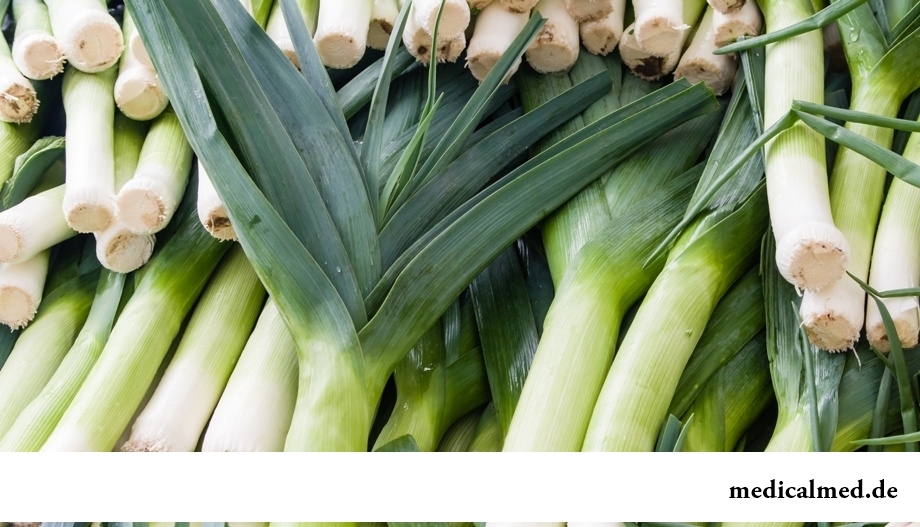
Food properties of leek do it by especially valuable food stuff for gourmets. In the absence of a pungent smell it possesses a gentle slaboostry shade of taste and aroma.
With the food purpose use false stalks and young green leaves of a plant. In the first year of life the socket of leaves and a stalk 10 - 60 cm long and with a diameter of 2 - 5 cm grows. It is productive body and comes to an end below with a thickening like bulbous. Flat linear leaves of a plant of green color, reach length of 90 cm and width of 3 - 6 cm. On the second year leek blossoms, the inflorescence has it an appearance of a spherical umbrella with a set of small white or pinkish flowers.
There are many grades of this plant, the greatest distribution was gained such of them as Mercury, Bulgarian late-ripening and Karathane.
Advantage of leek
Useful properties of leek are known since the Middle Ages. Now they are evidence-based thanks to the fact that the detailed structure of this plant is studied. The stalk and leaves of leek differ in the high content of useful microelements – calcium, potassium, phosphorus, iron, magnesium and sulfur. These substances participate in regulation of biochemical reactions and enter into structure of cells. Iron is important for the prevention of decrease in hemoglobin. Potassium improves cardiac performance, its salts as a part of a plant have weak diuretic effect. In addition leek contains cellulose and phytalbumins.
Leek is also vitamin-rich groups B, C, PP, A. The fact that at storage of onions the content of ascorbic acid in a white part of a false stalk not only does not decrease is interesting, but even raises by 1,5 times.
It should be noted advantage of leek at a scurvy, an urolithiasis, rheumatism, gout, atherosclerosis. It improves health and gives force at physical and mental overfatigue.
It is known of the properties of leek capable to normalize a metabolism, to increase functional activity of digestive glands with strengthening of production of enzymes and digestive juices. Therefore it can be recommended for the use to people with reduced appetite. Cholagogue properties of leek with success apply at congestive processes in a liver and at failures in its work.
Caloric content of leek makes about 40 kcal on 100 g of a product that is comparable to figures of energy value of onions. It allows to include leek in a diet to corpulent people. Thanks to the high content of useful salts it accelerates a metabolism. Because of low caloric content leek can be carried to dietary products at obesity.
Preparation of leek
Before using leek in food, it should be washed carefully under flowing cold water from the earth which gets between green leaves. Generally it is used fresh, sometimes in tinned. To reserve onions for the winter, it can be dried. The advantage of leek remains also in the frozen look, quite often it is frozen in mix with other vegetables. Its fresh stalks in the cool place remain fresh up to 5 months.
Leek is used as ingredient for meat and vegetable soups, salads, sauces, do of it puree, added to meat and fish dishes, fried eggs. Pleasant flavoring properties of these onions are well combined with cheese.
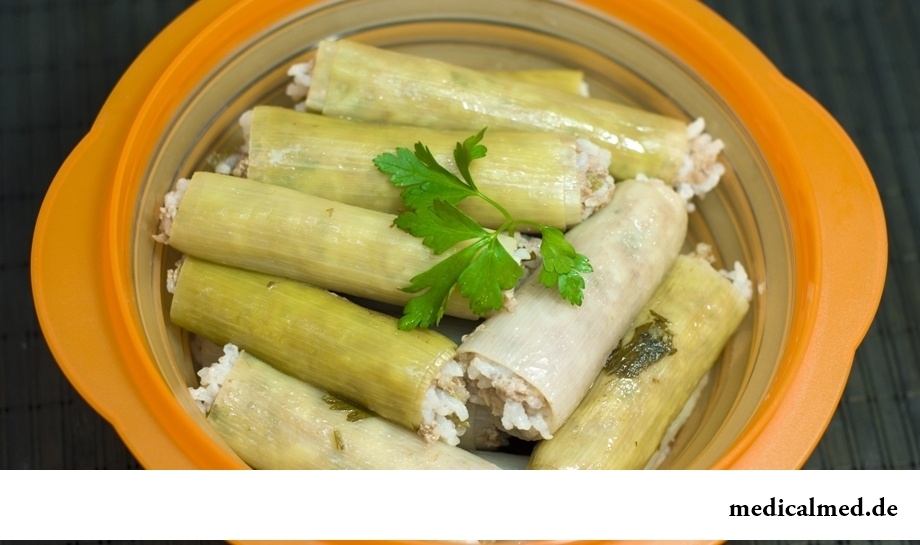
Contraindications to the use of leek
As this plant has ability to considerably stimulate digestive glands, it can provoke an aggravation of a gastroduodenit, a peptic ulcer of a stomach or duodenum. At these diseases it is necessary to be careful in the use of leek.
Human bones are stronger than concrete four times.

According to World Health Organization, every third inhabitant of Earth has excess weight, and every tenth suffers ожирен...
Section: Articles about health
You heard that laughter prolongs life? Researchers did not manage to establish longevity direct link with sincere fun yet, but several facts confirming beneficial influence of risibility on the state of health are clinically proved....
Section: Articles about health
It would seem, to buy drugs in Moscow does not make a problem – a drugstore, and not one, is available for each resident of the capital within walking distance. And, nevertheless, Internet drugstores become more popular – what it is possible to explain such phenomenon with? Actually there is a lot of reasons and if to formulate them it is short, then the most suitable word will be - "conveniently". We suggest to get acquainted in more detail with pluses and minuses of online drugstores that buying drugs, not to make the wrong choice....
Section: Articles about health
All are familiar with cold, and practically everyone believes that he has sufficient knowledge and experience that correctly to treat it. N...
Section: Articles about health
Hemorrhoids – extremely widespread disease. Periodically arising inflammations and bleeding of hemorrhoidal nodes cause serious discomfort to nearly fifteen percent of adults. Meanwhile, having a clear idea of the aggravation reasons...
Section: Articles about health
All diseases from nerves – in this joke a big element of truth, are said by doctors. Constant stresses lead to decrease in protective forces of an organism, and it becomes vulnerable for a set of diseases. It is wrong to think that the stress is a problem of the present. Life of people and hundred, and one thousand years ago also abounded with problems therefore need of a relaxation understood in ancient times – to some techniques more than one thousand years. The person needs knowledge of how it is possible to relax, this knowledge пригод...
Section: Articles about health
More than a half of the married couples which faced prostatitis – leave. The new broadcast "Female View of Prostatitis" will help to learn...
Section: Articles about health
Producers of milk mixes for children assure: mixes are ideally balanced and adapted for needs of babies. If mother should raise artificially the kid owing to serious problems with health, to do nothing – m substitutes...
Section: Articles about health
What will only not be thought up by persons interested to have a beautiful figure. Here the last innovation – for weight loss needs to be eaten greasy food. Let's understand whether there is at a fatty diet common sense....
Section: Slideshow
Cold is such painful that each sigh becomes a victory, heat "knocks" down, and the ache in joints forces to think only about...
Section: Articles about health
Cold, puffiness of a nose, itch, the watering eyes - characteristic symptoms of the allergic rhinitis resulting from hit of allergens (pollen, house dust, hair of animals, etc.) on a mucous membrane of a nose. Unpleasant feelings often deliver беспоко...
Section: Articles about health
Weakness of an ankle joint – very widespread problem. Its existence is demonstrated by tendency to a podvorachivaniye of legs when walking on heels, frequent painful sprains, pain on average and anonymous toes even after small loadings. Usually people with such pathology take off unpleasant effects by means of the anesthetizing pulverizing and ointments, but it does not lead to radical elimination of a problem. Meanwhile, at the known persistence it is possible to strengthen an ankle to the house...
Section: Articles about health
The medicine promptly develops, and the fact that else quite recently it seemed by miracle can now. We are not surprised any more to the fact that sport...
Section: Articles about health
The way of life of people promptly changes from year to year: if about ten years ago the personal computer was not in each family, then today already very few people do without this device. Certainly, and children master the computer at full speed: they not only I play...
Section: Articles about health
The word "onikhokriptoz" is unfamiliar to most of people, meanwhile quite so physicians call very widespread problem: the growing of edge of a nail into surrounding fabrics causing inflammatory process. Usually the illness affects thumbs of legs, and is followed by reddening, hypostasis, and in the started cases – release of pus. Patients complain of the pain amplifying when walking, problems with the choice of footwear....
Section: Articles about health
The stroke is one of the most widespread diseases of the person, annually in the world about 6 million cases эт are registered...
Section: Articles about health
It is pleasant to state a possibility of improvement of quality of life of people with problems of functioning of secretory system. Efforts of talented inventors created products which will be able to provide normal life activity of clients with moderate degree for...
Section: Articles about health
Coffee - the tonic loved by many for the invigorating aroma and deep taste. Having the stimulating effect, coffee increases working capacity, promotes concentration of attention, fights against drowsiness and improves mood. Statistically, about 30% of inhabitants of the planet regularly use coffee, from them more than 8% are "coffee-achievers" - the persons using more than 3 cups of drink a day....
Section: Articles about health
The nature does not stand stagnation and monotony. It is known that tissues of a human body atrophy if do not receive necessary loadings...
Section: Articles about health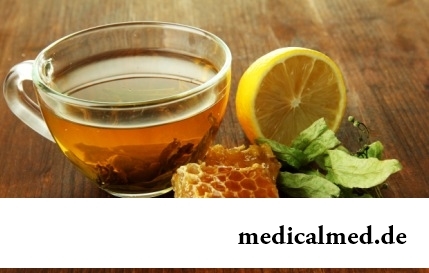
Cold – a state known to everyone which is followed by cold, cough, high temperature, a pharyngalgia. Often the first that we begin to do in hope again to become healthy – to accept medicines which are not always harmless, then...
Section: Articles about health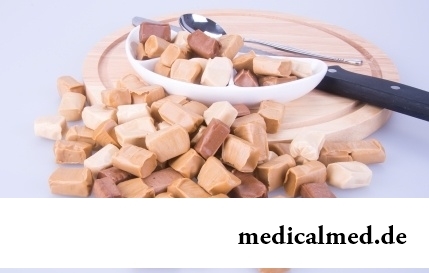
Food with the increased content of sugar is attractive to most of people - it is scientifically confirmed fact. Business here not in intemperance or dissoluteness: the sweet food is associated since childhood with feeling of rest and safety which tests the kid when it absorbs maternal milk. Besides, getting into a human body, sugar strengthens production of "happiness hormones" which all of us so need. And still life of sweet teeth seldom happens cloudless: their too big loss...
Section: Articles about health
Extracorporal fertilization – one of the most modern methods of controlling with infertility. So far it already helped znach...
Section: Articles about health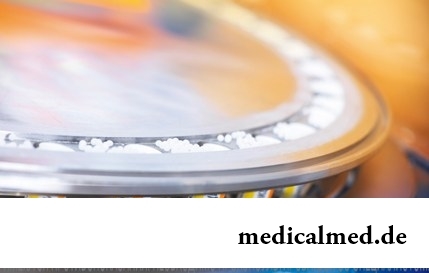
For the help to doctors in the choice of optimal solutions for treatment of various diseases the Cochrane scientific organization (Cochrane) conducts joint researches with representatives of scientific community around the world. The analysis of a series became carried out by one of the last methanolyses...
Section: Articles about health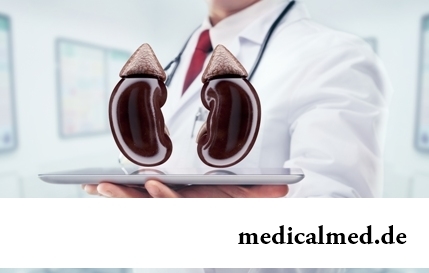
Kidneys perform the most important function of clarification of blood from those products of metabolic processes which cannot be used by an organism for obtaining energy and construction of new cells. With the urine produced by kidneys from a body of the person the bulk of the toxins getting to it with food and water is removed. Normal functioning of kidneys provides removal from an organism of excess liquid and maintenance of optimum ionic balance. At emergence of failures in work of secretory system...
Section: Articles about health
People know that thermal sources have salutary force long ago. Treatment by natural waters is one and...
Section: Articles about health
Neurosis is called pathology of a nervous system at which deviations in functioning of the highest nervous processes are observed. Most often - owing to yet not strengthened mentality - children are subject to neurosises. Premises to emergence of such disturbances can become нез...
Section: Articles about health
Physical activity is necessary for normal functioning of a human body. At a lack of the movement joints cease to function, muscles atrophy, cardiovascular activity is broken and the metabolism worsens. The modern city rhythm of life does not provide the person with an adequate exercise stress, additional - sport is necessary. Tedious tasks the huge number of the people having those or ин exists sport not all to liking, but also...
Section: Articles about health
